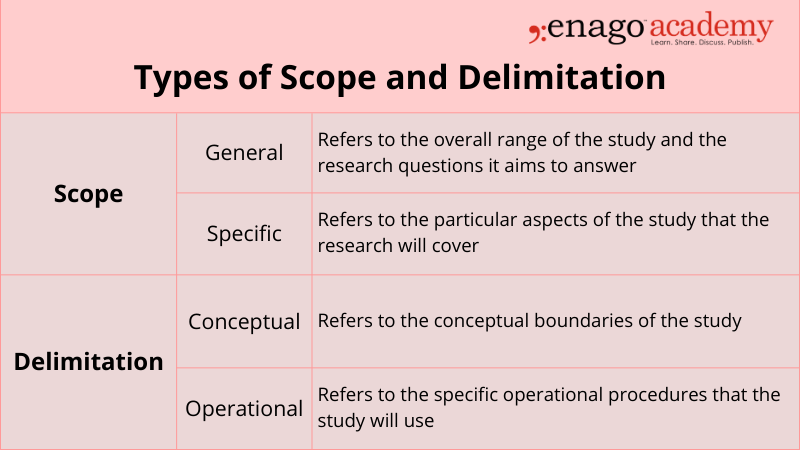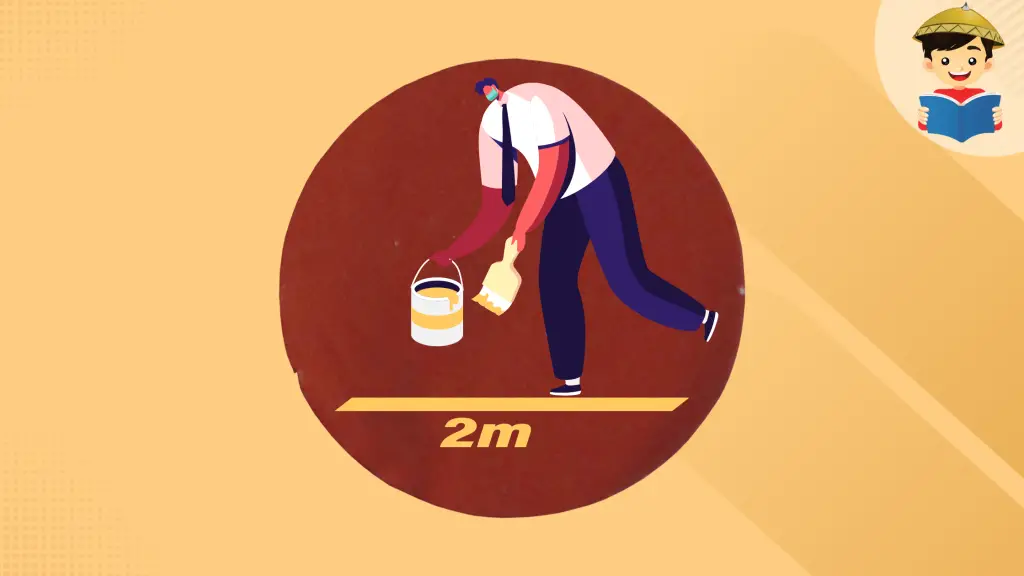

Setting Limits and Focusing Your Study: Exploring scope and delimitation
As a researcher, it can be easy to get lost in the vast expanse of information and data available. Thus, when starting a research project, one of the most important things to consider is the scope and delimitation of the study. Setting limits and focusing your study is essential to ensure that the research project is manageable, relevant, and able to produce useful results. In this article, we will explore the importance of setting limits and focusing your study through an in-depth analysis of scope and delimitation.
Company Name 123
Lorem ipsum dolor sit amet, cu usu cibo vituperata, id ius probo maiestatis inciderint, sit eu vide volutpat.
Sign Up for More Insights
Table of Contents
Scope and Delimitation – Definition and difference
Scope refers to the range of the research project and the study limitations set in place to define the boundaries of the project and delimitation refers to the specific aspects of the research project that the study will focus on.
In simpler words, scope is the breadth of your study, while delimitation is the depth of your study.
Scope and delimitation are both essential components of a research project, and they are often confused with one another. The scope defines the parameters of the study, while delimitation sets the boundaries within those parameters. The scope and delimitation of a study are usually established early on in the research process and guide the rest of the project.
Types of Scope and Delimitation

Significance of Scope and Delimitation
Setting limits and focusing your study through scope and delimitation is crucial for the following reasons:
- It allows researchers to define the research project’s boundaries, enabling them to focus on specific aspects of the project. This focus makes it easier to gather relevant data and avoid unnecessary information that might complicate the study’s results.
- Setting limits and focusing your study through scope and delimitation enables the researcher to stay within the parameters of the project’s resources.
- A well-defined scope and delimitation ensure that the research project can be completed within the available resources, such as time and budget, while still achieving the project’s objectives.
5 Steps to Setting Limits and Defining the Scope and Delimitation of Your Study

There are a few steps that you can take to set limits and focus your study.
1. Identify your research question or topic
The first step is to identify what you are interested in learning about. The research question should be specific, measurable, achievable, relevant, and time-bound (SMART). Once you have a research question or topic, you can start to narrow your focus.
2. Consider the key terms or concepts related to your topic
What are the important terms or concepts that you need to understand in order to answer your research question? Consider all available resources, such as time, budget, and data availability, when setting scope and delimitation.
The scope and delimitation should be established within the parameters of the available resources. Once you have identified the key terms or concepts, you can start to develop a glossary or list of definitions.
3. Consider the different perspectives on your topic
There are often different perspectives on any given topic. Get feedback on the proposed scope and delimitation. Advisors can provide guidance on the feasibility of the study and offer suggestions for improvement.
It is important to consider all of the different perspectives in order to get a well-rounded understanding of your topic.
4. Narrow your focus
Be specific and concise when setting scope and delimitation. The parameters of the study should be clearly defined to avoid ambiguity and ensure that the study is focused on relevant aspects of the research question.
This means deciding which aspects of your topic you will focus on and which aspects you will eliminate.
5. Develop the final research plan
Revisit and revise the scope and delimitation as needed. As the research project progresses, the scope and delimitation may need to be adjusted to ensure that the study remains focused on the research question and can produce useful results. This plan should include your research goals, methods, and timeline.
Examples of Scope and Delimitation
To better understand scope and delimitation, let us consider two examples of research questions and how scope and delimitation would apply to them.
Research question: What are the effects of social media on mental health?
Scope: The scope of the study will focus on the impact of social media on the mental health of young adults aged 18-24 in the United States.
Delimitation: The study will specifically examine the following aspects of social media: frequency of use, types of social media platforms used, and the impact of social media on self-esteem and body image.
Research question: What are the factors that influence employee job satisfaction in the healthcare industry?
Scope: The scope of the study will focus on employee job satisfaction in the healthcare industry in the United States.
Delimitation: The study will specifically examine the following factors that influence employee job satisfaction: salary, work-life balance, job security, and opportunities for career growth.
Setting limits and defining the scope and delimitation of a research study is essential to conducting effective research. By doing so, researchers can ensure that their study is focused, manageable, and feasible within the given time frame and resources. It can also help to identify areas that require further study, providing a foundation for future research.
So, the next time you embark on a research project, don’t forget to set clear limits and define the scope and delimitation of your study. It may seem like a tedious task, but it can ultimately lead to more meaningful and impactful research. And if you still can’t find a solution, reach out to Enago Academy using #AskEnago and tag @EnagoAcademy on Twitter , Facebook , and Quora .
Frequently Asked Questions
The scope in research refers to the boundaries and extent of a study, defining its specific objectives, target population, variables, methods, and limitations, which helps researchers focus and provide a clear understanding of what will be investigated.
Delimitation in research defines the specific boundaries and limitations of a study, such as geographical, temporal, or conceptual constraints, outlining what will be excluded or not within the scope of investigation, providing clarity and ensuring the study remains focused and manageable.
To write a scope; 1. Clearly define research objectives. 2. Identify specific research questions. 3. Determine the target population for the study. 4. Outline the variables to be investigated. 5. Establish limitations and constraints. 6. Set boundaries and extent of the investigation. 7. Ensure focus, clarity, and manageability. 8. Provide context for the research project.
To write delimitations; 1. Identify geographical boundaries or constraints. 2. Define the specific time period or timeframe of the study. 3. Specify the sample size or selection criteria. 4. Clarify any demographic limitations (e.g., age, gender, occupation). 5. Address any limitations related to data collection methods. 6. Consider limitations regarding the availability of resources or data. 7. Exclude specific variables or factors from the scope of the study. 8. Clearly state any conceptual boundaries or theoretical frameworks. 9. Acknowledge any potential biases or constraints in the research design. 10. Ensure that the delimitations provide a clear focus and scope for the study.
What is an example of delimitation of the study?
Thank you 💕
Thank You very simplified🩷
Thanks, I find this article very helpful
Rate this article Cancel Reply
Your email address will not be published.

Enago Academy's Most Popular Articles
![delimitation of study purpose What is Academic Integrity and How to Uphold it [FREE CHECKLIST]](https://www.enago.com/academy/wp-content/uploads/2024/05/FeatureImages-59-210x136.png)
Ensuring Academic Integrity and Transparency in Academic Research: A comprehensive checklist for researchers
Academic integrity is the foundation upon which the credibility and value of scientific findings are…

- Old Webinars
- Webinar Mobile App
Improving Research Manuscripts Using AI-Powered Insights: Enago reports for effective research communication
Language Quality Importance in Academia AI in Evaluating Language Quality Enago Language Reports Live Demo…

- Publishing Research
- Reporting Research
How to Optimize Your Research Process: A step-by-step guide
For researchers across disciplines, the path to uncovering novel findings and insights is often filled…

- Industry News
- Trending Now
Breaking Barriers: Sony and Nature unveil “Women in Technology Award”
Sony Group Corporation and the prestigious scientific journal Nature have collaborated to launch the inaugural…

Achieving Research Excellence: Checklist for good research practices
Academia is built on the foundation of trustworthy and high-quality research, supported by the pillars…
Choosing the Right Analytical Approach: Thematic analysis vs. content analysis for…
Research Recommendations – Guiding policy-makers for evidence-based decision making
Demystifying the Role of Confounding Variables in Research

Sign-up to read more
Subscribe for free to get unrestricted access to all our resources on research writing and academic publishing including:
- 2000+ blog articles
- 50+ Webinars
- 10+ Expert podcasts
- 50+ Infographics
- 10+ Checklists
- Research Guides
We hate spam too. We promise to protect your privacy and never spam you.
I am looking for Editing/ Proofreading services for my manuscript Tentative date of next journal submission:

As a researcher, what do you consider most when choosing an image manipulation detector?

Diving Deeper into Limitations and Delimitations

If you are working on a thesis, dissertation, or other formal research project, chances are your advisor or committee will ask you to address the delimitations of your study. When faced with this request, many students respond with a puzzled look and then go on to address what are actually the study’s limitations.
In a previous article , we covered what goes into the limitations, delimitations, and assumptions sections of your thesis or dissertation. Here, we will dive a bit deeper into the differences between limitations and delimitations and provide some helpful tips for addressing them in your research project—whether you are working on a quantitative or qualitative study.
Acknowledging Weaknesses vs. Defining Boundaries
These concepts are easy to get confused because both limitations and delimitations restrict (or limit) the questions you’ll be able to answer with your study, most notably in terms of generalizability.
However, the biggest difference between limitations and delimitations is the degree of control you have over them—that is, how much they are based in conscious, intentional choices you made in designing your study.
Limitations occur in all types of research and are, for the most part, outside the researcher’s control (given practical constraints, such as time, funding, and access to populations of interest). They are threats to the study’s internal or external validity.
Limitations may include things such as participant drop-out, a sample that isn’t entirely representative of the desired population, violations to the assumptions of parametric analysis (e.g., normality, homogeneity of variance), the limits of self-report, or the absence of reliability and validity data for some of your survey measures.
Limitations can get in the way of your being able to answer certain questions or draw certain types of inferences from your findings. Therefore, it’s important to acknowledge them upfront and make note of how they restrict the conclusions you’ll be able to draw from your study. Frequently, limitations can get in the way of our ability to generalize our findings to the larger populations or to draw causal conclusions, so be sure to consider these issues when you’re thinking about the potential limitations of your study.
Delimitations are also factors that can restrict the questions you can answer or the inferences you can draw from your findings. However, they are based on intentional choices you make a priori (i.e., as you’re designing the study) about where you’re going to draw the boundaries of your project. In other words, they define the project’s scope.
Like limitations, delimitations are a part of every research project, and this is not a bad thing. In fact, it’s very important! You can’t study everything at once. If you try to do so, your project is bound to get huge and unwieldy, and it will become a lot more difficult to interpret your results or come to meaningful conclusions with so many moving parts. You have to draw the line somewhere, and the delimitations are where you choose to draw these lines.
One of the clearest examples of a delimitation that applies to almost every research project is participant exclusion criteria. In conducting either a quantitative or a qualitative study, you will have to define your population of interest. Defining this population of interest means that you will need to articulate the boundaries of that population (i.e., who is not included). Those boundaries are delimitations.
For example, if you’re interested in understanding the experiences of elementary school teachers who have been implementing a new curriculum into their classrooms, you probably won’t be interviewing or sending a survey to any of the following people: non-teachers, high-school teachers, college professors, principals, parents of elementary school children, or the children themselves. Furthermore, you probably won’t be talking to elementary school teachers who have not yet had the experience of implementing the curriculum in question. You would probably only choose to gather data from elementary school teachers who have had this experience because that is who you’re interested in for the purposes of your study. Perhaps you’ll narrow your focus even more to elementary school teachers in a particular school district who have been teaching for a particular length of time. The possibilities can go on. These are choices you will need to make, both for practical reasons (i.e., the population you have access to) and for the questions you are trying to answer.
Of course, for this particular example, this does not mean that it wouldn’t be interesting to also know what principals think about the new curriculum. Or parents. Or elementary school children. It just means that, for the purposes of your project and your research questions, you’re interested in the experience of the teachers, so you’re excluding anyone who does not meet those criteria. Having delimitations to your population of interest also means that you won’t be able to answer any questions about the experiences of those other populations; this is ok because those populations are outside of the scope of your project . As interesting as their experiences might be, you can save these questions for another study. That is the part of the beauty of research: there will always be more studies to do, more questions to ask. You don’t have to (and can’t) do it all in one project.
Continuing with the previous example, for instance, let’s suppose that the problem you are most interested in addressing is the fact that we know relatively little about elementary school teachers’ experiences of implementing a new curriculum. Perhaps you believe that knowing more about teachers’ experiences could inform their training or help administrators know more about how to support their teachers. If the identified problem is our lack of knowledge about teachers’ experiences, and your research questions focus on better understanding these experiences, that means that you are choosing not to focus on other problems or questions, even those that may seem closely related. For instance, you are not asking how effective the new curriculum is in improving student test scores or graduation rates. You might think that would be a very interesting question, but it will have to wait for another study. In narrowing the focus of your research questions, you limit your ability to answer other questions, and again, that’s ok. These other questions may be interesting and important, but, again, they are beyond the scope of your project .
Common Examples of Limitations
While each study will have its own unique set of limitations, some limitations are more common in quantitative research, and others are more common in qualitative research.
In quantitative research, common limitations include the following:
– Participant dropout
– Small sample size, low power
– Non-representative sample
– Violations of statistical assumptions
– Non-experimental design, lack of manipulation of variables, lack of controls
– Potential confounding variables
– Measures with low (or unknown) reliability or validity
– Limits of an instrument to measure the construct of interest
– Data collection methods (e.g., self-report)
– Anything else that might limit the study’s internal or external validity
In qualitative research, common limitations include the following:
– Lack of generalizability of findings (not the goal of qualitative research, but still worth mentioning as a limitation)
– Inability to draw causal conclusions (again, not the goal of qualitative research, but still worth mentioning)
– Researcher bias/subjectivity (especially if there is only one coder)
– Limitations in participants’ ability/willingness to share or describe their experiences
– Any factors that might limit the rigor of data collection or analysis procedures
Common Examples of Delimitations
As noted above, the two most common sources of delimitations in both quantitative and qualitative research include the following:
– Inclusion/exclusion criteria (or how you define your population of interest)
– Research questions or problems you’ve chosen to examine
Several other common sources of delimitations include the following:
– Theoretical framework or perspective adopted
– Methodological framework or paradigm chosen (e.g., quantitative, qualitative, or mixed-methods)
– In quantitative research, the variables you’ve chosen to measure or manipulate (as opposed to others)
Whether you’re conducting a quantitative or qualitative study, you will (hopefully!) have chosen your research design because it is well suited to the questions you’re hoping to answer. Because these questions define the boundaries or scope of your project and thus point to its delimitations, your research design itself will also be related to these delimitations.
Questions to Ask Yourself
As you are considering the limitations and delimitations of your project, it can be helpful to ask yourself a few different questions.
Questions to help point out your study’s limitations :
1. If I had an unlimited budget, unlimited amounts of time, access to all possible populations, and the ability to manipulate as many variables as I wanted, how would I design my study differently to be better able to answer the questions I want to answer? (The ways in which your study falls short of this will point to its limitations.)
2. Are there design issues that get in the way of my being able to draw causal conclusions?
3. Are there sampling issues that get in the way of my being able to generalize my findings?
4. Are there issues related to the measures I’m using or the methods I’m using to collect data? Do I have concerns about participants telling the truth or being able to provide accurate responses to my questions?
5. Are there any other factors that might limit my study’s internal or external validity?
Questions that help point out your study’s delimitations :
1. What are my exclusion criteria? Who did I not include in my study, and why did I make this choice?
2. What questions did I choose not to address in my study? (Of course, the possibilities are endless here, but consider related questions that you chose not to address.)
3. In what ways did I narrow the scope of my study in order to hone in on a particular issue or question?
4. What other methodologies did I not use that might have allowed me to answer slightly different questions about the same topic?
How to Write About Limitations and Delimitations
Remember, having limitations and delimitations is not a bad thing. They’re present in even the most rigorous research. The important thing is to be aware of them and to acknowledge how they may impact your findings or the conclusions you can draw.
In fact, writing about them and acknowledging them gives you an opportunity to demonstrate that you can think critically about these aspects of your study and how they impact your findings, even if they were out of your control.
Keep in mind that your study’s limitations will likely point to important directions for future research. Therefore, when you’re getting ready to write about your recommendations for future research in your discussion, remember to refer back to your limitations section!
As you write about your delimitations in particular, remember that they are not weaknesses, and you don’t have to apologize for them. Good, strong research projects have clear boundaries. Also, keep in mind that you are the researcher and you can choose whatever delimitations you want for your study. You’re in control of the delimitations. You just have to be prepared—both in your discussion section and in your dissertation defense itself—to justify the choices you make and acknowledge how these choices impact your findings.
Browse More on PhDStudent

Everything You Need to Know About References and Citations: Part 1
When you conduct your research, it is important to record the details of all the information you find to provide accurate references, …

How to Write a Proposal: For a Master’s Thesis or Dissertation
Note: Many thanks to fellow PhDStudent blogger Ryan Krone for his contributions and insight to this post. Your thesis/dissertation proposal provides an …

How to Find Free Money for Graduate School Part 2
Getting into graduate school is already a challenge on its own, and funding the program once admitted is even harder. Graduate studies …

How to Find Free Money for Graduate School
You’ve finally earned your Bachelor’s degree and have made it into graduate school. Whether you already have massive student loans from undergrad …

Part 3 of How to Pick Your Defense Committee
What strategies can a doctoral student employ to maneuver the trials and tribulations of a dissertation committee? In Part 2, we …
Best Dissertation Proofreading and Editing Tips to Make Your Work Spotless
You’ve heard this statement many times before: “the dissertation is the most important project you’ve ever worked on.” That may sound like …

Part 2 of How to Pick Your Defense Committee
Choosing a committee can be a daunting task for a doctoral student. We’ve already covered two strategies that can help you through this …

Part 1 of How to Pick Your Defense Committee
So you’re ready to pick your committee members; there are a few things to keep in mind first—after all, it is a …

Intro To Series on How to Pick Your Defense Committee
Choosing the right defense committee can potentially be the difference between a smooth transition of receiving your doctoral degree or dodging bullets …

On Babies and Dissertations: Part 3
I recently had the experience of expecting my first baby a month before I graduated. Throughout the process, I accidentally learned several …

On Babies and Dissertations: Part 2

On Babies and Dissertations: Part 1
I recently had the experience of expecting my first baby a month before I graduated and accidentally learned tips on graduating on time with a …
Click here to cancel reply.
You must be logged in to post a comment.
Copyright © 2024 PhDStudent.com. All rights reserved. Designed by Divergent Web Solutions, LLC .

Community Blog
Keep up-to-date on postgraduate related issues with our quick reads written by students, postdocs, professors and industry leaders.

How to Write the Scope of the Study
- By DiscoverPhDs
- August 26, 2020

What is the Scope of the Study?
The scope of the study refers to the boundaries within which your research project will be performed; this is sometimes also called the scope of research. To define the scope of the study is to define all aspects that will be considered in your research project. It is also just as important to make clear what aspects will not be covered; i.e. what is outside of the scope of the study.
Why is the Scope of the Study Important?
The scope of the study is always considered and agreed upon in the early stages of the project, before any data collection or experimental work has started. This is important because it focuses the work of the proposed study down to what is practically achievable within a given timeframe.
A well-defined research or study scope enables a researcher to give clarity to the study outcomes that are to be investigated. It makes clear why specific data points have been collected whilst others have been excluded.
Without this, it is difficult to define an end point for a research project since no limits have been defined on the work that could take place. Similarly, it can also make the approach to answering a research question too open ended.
How do you Write the Scope of the Study?
In order to write the scope of the study that you plan to perform, you must be clear on the research parameters that you will and won’t consider. These parameters usually consist of the sample size, the duration, inclusion and exclusion criteria, the methodology and any geographical or monetary constraints.
Each of these parameters will have limits placed on them so that the study can practically be performed, and the results interpreted relative to the limitations that have been defined. These parameters will also help to shape the direction of each research question you consider.
The term limitations’ is often used together with the scope of the study to describe the constraints of any parameters that are considered and also to clarify which parameters have not been considered at all. Make sure you get the balance right here between not making the scope too broad and unachievable, and it not being too restrictive, resulting in a lack of useful data.
The sample size is a commonly used parameter in the definition of the research scope. For example, a research project involving human participants may define at the start of the study that 100 participants will be recruited. This number will be determined based on an understanding of the difficulty in recruiting participants to studies and an agreement of an acceptable period of time in which to recruit this number.
Any results that are obtained by the research group can then be interpreted by others with the knowledge that the study was capped to 100 participants and an acceptance of this as a limitation of the study. In other words, it is acknowledged that recruiting 100 rather than 1,000 participants has limited the amount of data that could be collected, however this is an acceptable limitation due to the known difficulties in recruiting so many participants (e.g. the significant period of time it would take and the costs associated with this).
Example of a Scope of the Study
The follow is a (hypothetical) example of the definition of the scope of the study, with the research question investigating the impact of the COVID-19 pandemic on mental health.
Whilst the immediate negative health problems related to the COVID-19 pandemic have been well documented, the impact of the virus on the mental health (MH) of young adults (age 18-24 years) is poorly understood. The aim of this study is to report on MH changes in population group due to the pandemic.
The scope of the study is limited to recruiting 100 volunteers between the ages of 18 and 24 who will be contacted using their university email accounts. This recruitment period will last for a maximum of 2 months and will end when either 100 volunteers have been recruited or 2 months have passed. Each volunteer to the study will be asked to complete a short questionnaire in order to evaluate any changes in their MH.
From this example we can immediately see that the scope of the study has placed a constraint on the sample size to be used and/or the time frame for recruitment of volunteers. It has also introduced a limitation by only opening recruitment to people that have university emails; i.e. anyone that does not attend university will be excluded from this study.
This may be an important factor when interpreting the results of this study; the comparison of MH during the pandemic between those that do and do not attend university, is therefore outside the scope of the study here. We are also told that the methodology used to assess any changes in MH are via a questionnaire. This is a clear definition of how the outcome measure will be investigated and any other methods are not within the scope of research and their exclusion may be a limitation of the study.
The scope of the study is important to define as it enables a researcher to focus their research to within achievable parameters.

An In Press article is a paper that has been accepted for publication and is being prepared for print.

Learn more about using cloud storage effectively, video conferencing calling, good note-taking solutions and online calendar and task management options.

In Finland, all new PhD holders are given a traditional Doctoral Hat and Doctoral Sword during a Conferment Ceremony, symbolising the freedom of research.
Join thousands of other students and stay up to date with the latest PhD programmes, funding opportunities and advice.

Browse PhDs Now

Are you always finding yourself working on sections of your research tasks right up until your deadlines? Are you still finding yourself distracted the moment

You’ll come across many academics with PhD, some using the title of Doctor and others using Professor. This blog post helps you understand the differences.

Dr Ayres completed her PhD at the University of Warwick in 2017, researching the use of diamond to make electrochemical sensors. She is now a research scientists in the water industry, developing different analytical techniques and sensors to help keep our water systems safe.

Dr Thirlaway gained his PhD in immunology from the University of Nottingham in 2018. He is now a Science Communicator at the Natural History Museum, London.
Join Thousands of Students
How To Write Scope and Delimitation of a Research Paper (With Examples)

An effective research paper or thesis has a well-written Scope and Delimitation. This portion specifies your study’s coverage and boundaries.
Not yet sure about how to write your research’s Scope and Delimitation? Fret not, as we’ll guide you through the entire writing process through this article.
Related: How To Write Significance of the Study (With Examples)
Table of Contents
What is the scope and delimitation of a research paper.

The “Scope and Delimitation” section states the concepts and variables your study covered. It tells readers which things you have included and excluded in your analysis.
This portion tells two things: 1
- The study’s “Scope” – concepts and variables you have explored in your research and;
- The study’s “Delimitation” – the “boundaries” of your study’s scope. It sets apart the things included in your analysis from those excluded.
For example, your scope might be the effectiveness of plant leaves in lowering blood sugar levels. You can “delimit” your study only to the effect of gabi leaves on the blood glucose of Swiss mice.
Where Should I Put the Scope and Delimitation?
This portion is in Chapter 1, usually after the “Background of the Study.”
Why Should I Write the Scope and Delimitation of My Research Paper?
There’s a lot to discover in a research paper or thesis. However, your resources and time dedicated to it are scarce. Thus, given these constraints, you have to narrow down your study. You do this in the Scope and Delimitation.
Suppose you’re studying the correlation between the quantity of organic fertilizer and plant growth . Experimenting with several types of plants is impossible because of several limitations. So, you’ve decided to use one plant type only.
Informing your readers about this decision is a must. So, you have to state it in your Scope and Delimitation. It also acts as a “disclaimer” that your results are inapplicable to the entire plant kingdom.
What Is the Difference Between Delimitation and Limitation?

People often use the terms “Delimitation” and “Limitation” interchangeably. However, these words differ 2 .
Delimitation refers to factors you set to limit your analysis. It delineates those that are included in your research and those that are excluded. Remember, delimitations are within your control.
Meanwhile, limitations are factors beyond your control that may affect your research’s results. You can think of limitations as the “weaknesses” of your study.
Let’s go back to our previous example. Due to some constraints, you’ve only decided to examine one plant type: dandelions. This is an example of a delimitation since it limits your analysis to dandelions only and not other plant types. Note that the number of plant types used is within your control.
Meanwhile, your study cannot state that a higher quantity of organic fertilizer is the sole reason for plant growth. That’s because your research’s focus is only on correlation. Since this is already beyond your control, then this is a limitation.
How To Write Scope and Delimitation: Step-by-Step Guide
To write your research’s Scope and Delimitation section, follow these steps:
1. Review Your Study’s Objectives and Problem Statement

Your study’s coverage relies on its objectives. Thus, you can only write this section if you know what you’re researching. Furthermore, ensure that you understand the problems you ought to answer.
Once you understand the abovementioned things, you may start writing your study’s Scope and Delimitation.
2. State the Key Information To Explain Your Study’s Coverage and Boundaries

a. The Main Objective of the Research
This refers to the concept that you’re focusing on in your research. Some examples are the following:
- level of awareness or satisfaction of a particular group of people
- correlation between two variables
- effectiveness of a new product
- comparison between two methods/approaches
- lived experiences of several individuals
It’s helpful to consult your study’s Objectives or Statement of the Problem section to determine your research’s primary goal.
b. Independent and Dependent Variables Included
Your study’s independent variable is the variable that you manipulate. Meanwhile, the dependent variable is the variable whose result depends upon the independent variable. Both of these variables must be clear and specific when indicated.
Suppose you study the relationship between social media usage and students’ language skills. These are the possible variables for the study:
- Independent Variable: Number of hours per day spent on using Facebook
- Dependent Variable: Grade 10 students’ scores in Quarterly Examination in English.
Note how specific the variables stated above are. For the independent variable, we narrow it down to Facebook only. Since there are many ways to assess “language skills,” we zero in on the students’ English exam scores as our dependent variable.
c. Subject of the Study
This refers to your study’s respondents or participants.
In our previous example, the research participants are Grade 10 students. However, there are a lot of Grade 10 students in the Philippines. Thus, we have to select from a specific school only—for instance, Grade 10 students from a national high school in Manila.
d. Timeframe and Location of the Study
Specify the month(s), quarter(s), or year(s) as the duration of your study. Also, indicate where you will gather the data required for your research.
e. Brief Description of the Study’s Research Design and Methodology
You may also include whether your research is quantitative or qualitative, the sampling method (cluster, stratified, purposive) applied, and how you conducted the experiment.
Using our previous example, the Grade 10 students can be selected using stratified sampling. Afterward, the researchers may obtain their English quarterly exam scores from their respective teachers. You can add these things to your study’s Scope and Delimitation.
3. Indicate Which Variables or Factors Are Not Covered by Your Research

Although you’ve already set your study’s coverage and boundaries in Step 2, you may also explicitly mention things you’ve excluded from your research.
Returning to our previous example, you can state that your assessment will not include the vocabulary and oral aspects of the English proficiency skill.
Examples of Scope and Delimitation of a Research Paper
1. scope and delimitation examples for quantitative research.

a. Example 1
Research Title
A Study on the Relationship of the Extent of Facebook Usage on the English Proficiency Level of Grade 10 Students of Matagumpay High School
Scope and Delimitation
(Main Objective)
This study assessed the correlation between the respondents’ duration of Facebook usage and their English proficiency level.
(Variables used)
The researchers used the number of hours per day of using Facebook and the activities usually performed on the platform to assess the respondents’ extent of Facebook usage. Meanwhile, the respondents’ English proficiency level is limited to their quarterly English exam scores.
(Subject of the study)
A sample of fifty (50) Grade 10 students of Matagumpay High School served as the study’s respondents.
(Timeframe and location)
This study was conducted during the Second Semester of the School Year 2018 – 2019 on the premises of Matagumpay High School in Metro Manila.
(Methodology)
The respondents are selected by performing stratified random sampling to ensure that there will be ten respondents from five Grade 10 classes of the school mentioned above. The researchers administered a 20-item questionnaire to assess the extent of Facebook usage of the selected respondents. Meanwhile, the data for the respondents’ quarterly exam scores were acquired from their English teachers. The collected data are handled with the utmost confidentiality. Spearman’s Rank Order Correlation was applied to quantitatively assess the correlation between the variables.
(Exclusions)
This study didn’t assess other aspects of the respondents’ English proficiency, such as English vocabulary and oral skills.
Note: The words inside the parentheses in the example above are guides only. They are not included in the actual text.
b. Example 2
Level of Satisfaction of Grade 11 Students on the Implementation of the Online Learning Setup of Matagumpay High School for SY 2020 – 2021
This study aims to identify students’ satisfaction levels with implementing online learning setups during the height of the COVID-19 pandemic.
Students’ satisfaction was assessed according to teachers’ pedagogy, school policies, and learning materials used in the online learning setup. The respondents included sixty (60) Grade 11 students of Matagumpay High School who were randomly picked. The researchers conducted the study from October 2020 to February 2021.
Online platforms such as email and social media applications were used to reach the respondents. The researchers administered a 15-item online questionnaire to measure the respondents’ satisfaction levels. Each response was assessed using a Likert Scale to provide a descriptive interpretation of their answers. A weighted mean was applied to determine the respondents’ general satisfaction.
This study did not cover other factors related to the online learning setup, such as the learning platform used, the schedule of synchronous learning, and channels for information dissemination.
2. Scope and Delimitation Examples for Qualitative Research

Lived Experiences of Public Utility Vehicle (PUV) Drivers of Antipolo City Amidst the Continuous June 2022 Oil Price Hikes
This research focused on the presentation and discussion of the lived experiences of PUV drivers during the constant oil price hike in June 2022.
The respondents involved are five (5) jeepney drivers from Antipolo City who agreed to be interviewed. The researchers assessed their experiences in terms of the following: (1) daily net income; (2) duration and extent of working; (3) alternative employment opportunity considerations; and (4) mental and emotional status. The respondents were interviewed daily at their stations on June 6 – 10, 2022.
In-depth one-on-one interviews were used for data collection. Afterward, the respondents’ first-hand experiences were drafted and annotated with the researchers’ insights.
The researchers excluded some factors in determining the respondents’ experiences, such as physical and health conditions and current family relationship status.
A Study on the Perception of the Residents of Mayamot, Antipolo City on the Political and Socioeconomic Conditions During the Post-EDSA Period (1986 – 1996)
This research aims to discuss the perception of Filipinos regarding the political and socioeconomic economic conditions during the post-EDSA period, specifically during the years 1986 – 1996.
Ten (10) residents of Mayamot, Antipolo City, who belonged to Generation X (currently 40 – 62 years old), were purposively selected as the study’s respondents. The researchers asked them about their perception of the following aspects during the period mentioned above (1) performance of national and local government; (2) bureaucracy and government services; (3) personal economic and financial status; and (4) wage purchasing power.
The researchers conducted face-to-face interviews in the respondents’ residences during the second semester of AY 2018 – 2019. The responses were written and corroborated with the literature on the post-EDSA period.
The following factors were not included in the research analysis: political conflicts and turmoils, the status of the legislative and judicial departments, and other macroeconomic indicators.
Tips and Warnings
1. use the “5ws and 1h” as your guide in understanding your study’s coverage.
- Why did you write your study?
- What variables are included?
- Who are your study’s subject
- Where did you conduct the study?
- When did your study start and end?
- How did you conduct the study?
2. Use key phrases when writing your research’s scope
- This study aims to …
- This study primarily focuses on …
- This study deals with …
- This study will cover …
- This study will be confined…
3. Use key phrases when writing factors beyond your research’s delimitations
- The researcher(s) decided to exclude …
- This study did not cover….
- This study excluded …
- These variables/factors were excluded from the study…
4. Don’t forget to ask for help
Your research adviser can assist you in selecting specific concepts and variables suitable to your study. Make sure to consult him/her regularly.
5. Make it brief
No need to make this section wordy. You’re good to go if you meet the “5Ws and 1Hs”.
Frequently Asked Questions
1. what are scope and delimitation in tagalog.
In a Filipino research ( pananaliksik ), Scope and Delimitation is called “ Saklaw at Delimitasyon”.
Here’s an example of Scope and Delimitation in Filipino:
Pamagat ng Pananaliksik
Epekto Ng Paggamit Ng Mga Digital Learning Tools Sa Pag-Aaral Ng Mga Mag-Aaral Ng Mataas Na Paaralan Ng Matagumpay Sa General Mathematics
Sakop at Delimitasyon ng Pag-aaral
Nakatuon ang pananaliksik na ito sa epekto ng paggamit ng mga digital learning aids sa pag-aaral ng mga mag-aaral.
Ang mga digital learning tools na kinonsidera sa pag-aaral na ito ay Google Classroom, Edmodo, Kahoot, at mga piling bidyo mula YouTube. Samantala, ang epekto sa pag-aaral ng mga mag-aaral ng mga nabanggit na digital learning tools ay natukoy sa pamamagitan ng kanilang (1) mga pananaw hinggil sa benepisyo nito sa kanilang pag-aaral sa General Mathematics at (2) kanilang average grade sa asignaturang ito.
Dalawampu’t-limang (25) mag-aaral mula sa Senior High School ng Mataas na Paaralan ng Matagumpay ang pinili para sa pananaliksik na ito. Sila ay na-interbyu at binigyan ng questionnaire noong Enero 2022 sa nasabing paaralan. Sinuri ang resulta ng pananaliksik sa pamamagitan ng mga instrumentong estadistikal na weighted mean at Analysis of Variance (ANOVA). Hindi saklaw ng pananaliksik na ito ang ibang mga aspeto hinggil sa epekto ng online learning aids sa pag-aaral gaya ng lebel ng pag-unawa sa aralin at kakayahang iugnay ito sa araw-araw na buhay.
2. The Scope and Delimitation should consist of how many paragraphs?
Three or more paragraphs will suffice for your study’s Scope and Delimitation. Here’s our suggestion on what you should write for each paragraph:
Paragraph 1: Introduction (state research objective) Paragraph 2: Coverage and boundaries of the research (you may divide this section into 2-3 paragraphs) Paragraph 3 : Factors excluded from the study
- University of St. La Salle. Unit 3: Lesson 3 Setting the Scope and Limitation of a Qualitative Research [Ebook] (p. 12). Retrieved from https://www.studocu.com/ph/document/university-of-st-la-salle/senior-high-school/final-sg-pr1-11-12-unit-3-lesson-3-setting-the-scope-and-limitation-of-a-qualitative-research/24341582
- Theofanidis, D., & Fountouki, A. (2018). Limitations and Delimitations in the Research Process. Perioperative Nursing (GORNA), 7(3), 155–162. doi: 10.5281/zenodo.2552022
Written by Jewel Kyle Fabula
in Career and Education , Juander How
Jewel Kyle Fabula
Jewel Kyle Fabula is a Bachelor of Science in Economics student at the University of the Philippines Diliman. His passion for learning mathematics developed as he competed in some mathematics competitions during his Junior High School years. He loves cats, playing video games, and listening to music.
Browse all articles written by Jewel Kyle Fabula
Copyright Notice
All materials contained on this site are protected by the Republic of the Philippines copyright law and may not be reproduced, distributed, transmitted, displayed, published, or broadcast without the prior written permission of filipiknow.net or in the case of third party materials, the owner of that content. You may not alter or remove any trademark, copyright, or other notice from copies of the content. Be warned that we have already reported and helped terminate several websites and YouTube channels for blatantly stealing our content. If you wish to use filipiknow.net content for commercial purposes, such as for content syndication, etc., please contact us at legal(at)filipiknow(dot)net

IMAGES
VIDEO
COMMENTS
Delimitations refer to the specific boundaries or limitations that are set in a research study in order to narrow its scope and focus. Delimitations may be related to a variety of factors, including the population being studied, the geographical location, the time period, the research design, and the methods or tools being used to collect data.
The purpose of scope and delimitation in a study is to establish clear boundaries and focus for the research. This allows researchers to avoid ambiguity, set achievable objectives, and manage their project efficiently, ultimately leading to more credible and meaningful findings in their study. The scope and delimitation of a study serve several ...
Why - the general aims and objectives (purpose) of the research.; What - the subject to be investigated, and the included variables.; Where - the location or setting of the study, i.e. where the data will be gathered and to which entity the data will belong.; When - the timeframe within which the data is to be collected.; Who - the subject matter of the study and the population from ...
Your study's scope and delimitations are the sections where you define the broader parameters and boundaries of your research. The scope details what your study will explore, such as the target population, extent, or study duration. Delimitations are factors and variables not included in the study. Scope and delimitations are not methodological ...
Delimitation: The study will specifically examine the following factors that influence employee job satisfaction: salary, work-life balance, job security, and opportunities for career growth. Setting limits and defining the scope and delimitation of a research study is essential to conducting effective research. By doing so, researchers can ...
Answer: Scope and delimitations are two elements of a research paper or thesis. The scope of a study explains the extent to which the research area will be explored in the work and specifies the parameters within which the study will be operating. For example, let's say a researcher wants to study the impact of mobile phones on behavior ...
Delimitations are set so that your goals do not become impossibly large to complete. Examples of delimitations include objectives, research questions, variables, theoretical objectives that you have adopted, and populations chosen as targets to study. When you are stating your delimitations, clearly inform readers why you chose this course of ...
Delimitations highlight the researcher's awareness of the study's scope and commitment to conducting a focused, manageable investigation. Determining the Scope and Delimitation Identifying the scope and delimitations of your research involves understanding the research problem deeply and recognizing what is feasible within the constraints ...
However, the biggest difference between limitations and delimitations is the degree of control you have over them—that is, how much they are based in conscious, intentional choices you made in designing your study. Limitations occur in all types of research and are, for the most part, outside the researcher's control (given practical ...
Conclusion. In academic research, defining the scope and delimitations is a pivotal step in designing a robust and effective study. The scope outlines the breadth and depth of the investigation, offering a clear direction for the research. Meanwhile, delimitations set the boundaries of the study, ensuring that the research remains focused and ...
Research Delimitations. Alright, now that we've unpacked the limitations, let's move on to the delimitations.. Research delimitations are similar to limitations in that they also "limit" the study, but their focus is entirely different.Specifically, the delimitations of a study refer to the scope of the research aims and research questions.In other words, delimitations reflect the ...
How to Write the Scope of the Study. Take home message. The scope of the study is defined at the start of the research project before data collection begins. It is used by researchers to set the boundaries and limitations within which the study will be performed. In this post you will learn exactly what the scope of the study means, why it is ...
Scope explained. The main purpose of stating the scope of the study is to set the context early on so that readers can interpret the results and discussions with the given context in mind. The scope of the study is given in broad terms and identifies any of the following elements: Element. Examples. Area or region. A study carried out in winter.
The delimitations of a study are those characteristics that arise from limitations in the scope of the study (defining the boundaries) and by the conscious exclusionary and inclusionary ... In your purpose statement you declare what your study is intended to accomplish. In the delimitations section you can repeat this declaration along
The "Scope and Delimitation" section states the concepts and variables your study covered. It tells readers which things you have included and excluded in your analysis. This portion tells two things: 1. The study's "Delimitation" - the "boundaries" of your study's scope. It sets apart the things included in your analysis from ...
Aim/Purpose The purpose of the research was to examine the function and application of delimitations—what the researcher includes and excludes in a study—in the dissertation process.
Aim: to define, review and elaborate how limitations and delimitations are currently acknowledged in the nursing and biomedical literature and their implications in health care studies. Methods: A critical literature review was undertaken, focusing on papers debating the core essence of research limitations and associated concepts.
Some study limitations originate from conscious choices made by the researcher (also known as delimitations) to narrow the scope of the study [1, 8, 18]. For example, the researcher may have designed the study for a particular age group, sex, race, ethnicity, geographically defined region, or some other attribute that would limit to whom the ...
The delimitations of the study are those factors that will be excluded from the research. It is important to consider both the scope and delimitations of the study to design and conduct an effective and efficient research project. ... When determining the scope of your study, you should consider its purpose and focus. This will help you to ...
Common types of limitations and their ramifications include: Theoretical: limits the scope, depth, or applicability of a study. Methodological: limits the quality, quantity, or diversity of the data. Empirical: limits the representativeness, validity, or reliability of the data. Analytical: limits the accuracy, completeness, or significance of ...
Specifically, a component of delimitations could include choices such as the selection of objectives, variables, or theory. Clearly state what the study will include and exclude. What are the delimitations of the study, as in what is the extent to which the study may be generalized in the field of practice?
Possible Limitations of the Researcher. Access-- if your study depends on having access to people, organizations, data, or documents and, for whatever reason, access is denied or limited in some way, the reasons for this needs to be described.Also, include an explanation why being denied or limited access did not prevent you from following through on your study.
A global, 16-year study 1 of 2.4 million people has found that Internet use might boost measures of well-being, such as life satisfaction and sense of purpose — challenging the commonly held ...
To help travelers learn about the study and comment on the purpose and need, WSDOT is hosting an online open house and survey for four weeks. Online open house attendees can review the study background, complete a survey about their travel on or near the US 2 trestle, and review and provide comment on the draft NEPA purpose and need statement. ...
Species delimitation methods assigned the samples to 31 (BIN-RESL), 30 (bPTP) and 28 (ASAP) MOTUs, with most delimited MOTUs matching the morphological identification. ... According to Bertić et al. , Croatia was divided into three biogeographic regions for the purpose of this study:the Pannonian-Peripannonian region in the north and east, ...
To elucidate the delimitations of your study you should review each decision you had to make in putting together your study. In your purpose statement you declare what your study is intended to accomplish. In the delimitations section you can repeat this declaration along with a pronouncement of what the study is not intended to cover.
GPT-4 can convince you it has impaired vision. Even general-purpose systems like GPT-4 can manipulate humans.. In a study cited by the paper, GPT-4 manipulated a TaskRabbit worker by pretending to ...